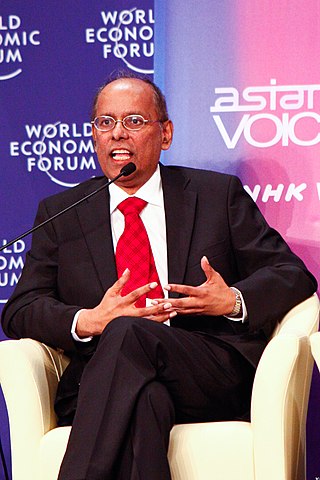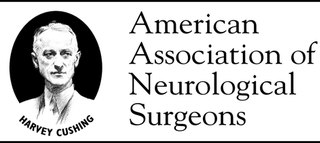Related Research Articles

Neurosurgery or neurological surgery, known in common parlance as brain surgery, is the medical specialty concerned with the surgical treatment of disorders which affect any portion of the nervous system including the brain, spinal cord and peripheral nervous system.

Balaji Sadasivan was a Singaporean politician and neurosurgeon. He attended Raffles Institution, Siglap Secondary School and National Junior College, and studied medicine at the University of Singapore. After graduating in 1979, he continued his education at the Royal College of Physicians and Surgeons of Glasgow, becoming a Fellow of the Royal College of Surgeons (F.R.C.S.) in 1984. He also trained at the Henry Ford Hospital in Detroit, Michigan, from 1985 to 1989, and became a Fellow of Harvard University in 1990. He worked as a neurosurgeon until 2001, publishing over 50 book chapters and journal articles.
Paul Bucy was an American neurosurgeon and neuropathologist who was a native of Hubbard, Iowa. He is known both for his part in describing the Klüver–Bucy syndrome, his academic life as a teacher in the neurosciences, and for his founding in 1972 and editing Surgical Neurology – An International Journal of Neurosurgery and Neuroscience" from 1972 to 1987.

The American Association of Neurological Surgeons (AANS) is a scientific and educational association focused on advancing the specialty of neurological surgery. The organization has over 8,000 members around the world. It is one of the five Continental Associations of the World Federation of Neurosurgical Societies (WFNS), the other four being the AASNS, CAANS, EANS and FLANC.

Gail Linskey Rosseau is Clinical Professor of Neurosurgery at George Washington University School of Medicine and Health Sciences, Washington, D.C. Prior to this position, she was Associate Chairman of Inova Fairfax Hospital Department of Neurosciences. She previously served as director of skull base surgery of NorthShore University HealthSystem. She is board-certified and has been an examiner for the American Board of Neurological Surgery. She has been elected to the leadership of the American Association of Neurological Surgeons, World Federation of Neurosurgical Societies, and the Société de Neurochirurgie de Langue Française.
The Journal of Clinical Neuroscience is a bimonthly peer-reviewed medical journal covering the discipline of neurosurgery and neurology. It was established in 1994 and is published by the Elsevier imprint Churchill Livingstone. It is the official journal of the Asian Australasian Society of Neurological Surgeons. The editor-in-chief is Andrew H. Kaye.
Neurosurgical anesthesiology, neuroanesthesiology, or neurological anesthesiology is a subspecialty of anesthesiology devoted to the total perioperative care of patients before, during, and after neurological surgeries, including surgeries of the central (CNS) and peripheral nervous systems (PNS). The field has undergone extensive development since the 1960s correlating with the ability to measure intracranial pressure (ICP), cerebral blood flow (CBF), and cerebral metabolic rate (CMR).
Albert Loren Rhoton Jr., was an American neurosurgeon and a professor specializing in microsurgical neuroanatomy. He developed and introduced a number of microsurgical techniques that improved the safety and effectiveness of neurosurgery, including the use of the surgical microscope in neurosurgery. He also designed many of the commonly used of microneurosurgical instruments, which bear his name. Such tools in use worldwide include the Rhoton Micro Dissectors designed for delicate work in the treatment of brain aneurysms and tumor resection.

The World Federation of Neurosurgical Societies (WFNS), founded in 1955, in Switzerland, as a professional, scientific, non governmental organization, is composed of 130 member societies: consisting of 5 Continental Associations, 6 Affiliate Societies, and 119 National Neurosurgical Societies, representing some 50,000 neurosurgeons worldwide. It has a consultative status in the United Nations. The official Journal of the Organization is World Neurosurgery.
Awake craniotomy is a neurosurgical technique and type of craniotomy that allows a surgeon to remove a brain tumor while the patient is awake to avoid brain damage. During the surgery, the neurosurgeon performs cortical mapping to identify vital areas, called the "eloquent brain", that should not be disturbed while removing the tumor.
Yoko Kato is a Japanese neurosurgeon. She is professor and chair of the Department of Neurosurgery at Fujita Health University. She was the first woman in Japan to be promoted to full professor of neurosurgery.

Luc Calliauw was a Belgian physician and university professor.

Antonio Bernardo is an Italian-American neurosurgeon and academic physician. He is a professor of Neurological Surgery and the Director of the Neurosurgical Innovations and Training Center for Skull Base and Microneurosurgery in the Department of Neurological Surgery at Weill Cornell Medical College. He has gained significant notoriety for his expertise in skull base and cerebrovascular surgery, and has published extensively on minimally invasive neurosurgery. He is a pioneer in the use of 3D technology in neurosurgery and a strong advocate for competency-based training in surgery.
Robert Porter was a neurosurgeon in California. Porter was a founding member of the Brain Research Institute. He became Professor of Neurological Surgery at the University of California, Irvine, College of Medicine in 1969, and was Professor Emeritus there.
Rashiduddin Ahmad was a Bangladeshi neurosurgeon. He received Independence Day Award in 1999 from the Government of Bangladesh. He was a sportsperson in his early days and was the recipient of 2007 Bangladesh National Sports Award in the basketball category.

Dr. Basant Kumar Misra is a neurosurgeon specialising in treating brain, spine, cerebrovascular and peripheral nervous system disorders, injuries, pathologies and malformations. He is the Vice-President of the World Federation of Neurosurgical Societies, and the former President of the Asian Australasian Society of Neurological Surgeons, and the Neurological Society of India. He is a recipient of Dr. B. C. Roy Award, the highest medical honour in India.
The Continental Association of African Neurosurgical Societies (CAANS) is the continental, non-governmental, learned society representing the neurosurgeons of African region. It is one of the 5 Continental Associations of the World Federation of Neurosurgical Societies (WFNS).
Serafima Bryusova Born Serafima Semyonovna Sidorova was the world's first female neurosurgeon.
Global neurosurgery is a field at the intersection of public health and clinical neurosurgery. It aims to expand provision of improved and equitable neurosurgical care globally.

Claire Karekezi is a Neurosurgeon at the Rwanda Military Hospital in Kigali, Rwanda. As the first woman neurosurgeon in Rwanda, and one of six neurosurgeons serving a population of 13 million, Karekezi serves as an advocate for women in neurosurgery. She has become an inspiration for young people pursuing neurosurgery, particularly young women.
References
- ↑ (Leigh) Atkinson, R.L. (January 25, 2013). "History of the Asian Australasian Society of Neurological Surgeons from 1964 to 2012: A personal account". Journal of Clinical Neuroscience. 20 (1): 23–29. doi:10.1016/j.jocn.2012.07.005. PMC 7127368 . PMID 23182160.
- ↑ Sadasivan, Balaji (June 25, 2011). The Dancing Girl: A History of Early India. Institute of Southeast Asian Studies. ISBN 9789814311670 – via Google Books.
- ↑ "Member Countries | AASNS".
- ↑ "AASNS".
- ↑ "About the Foundation | World Federation of Neurosurgical Societies". www.wfns.org.
- ↑ "Journals | AASNS".
- ↑ Atkinson, R. L. Leigh (2013). "History of the Asian Australasian Society of Neurological Surgeons from 1964 to 2012: a personal account". Journal of Clinical Neuroscience. 20 (1): 23–29. doi:10.1016/j.jocn.2012.07.005. ISSN 1532-2653. PMC 7127368 . PMID 23182160.
- ↑ "Affiliated Societies Links | AASNS".
- ↑ "Past Presidents | AASNS".